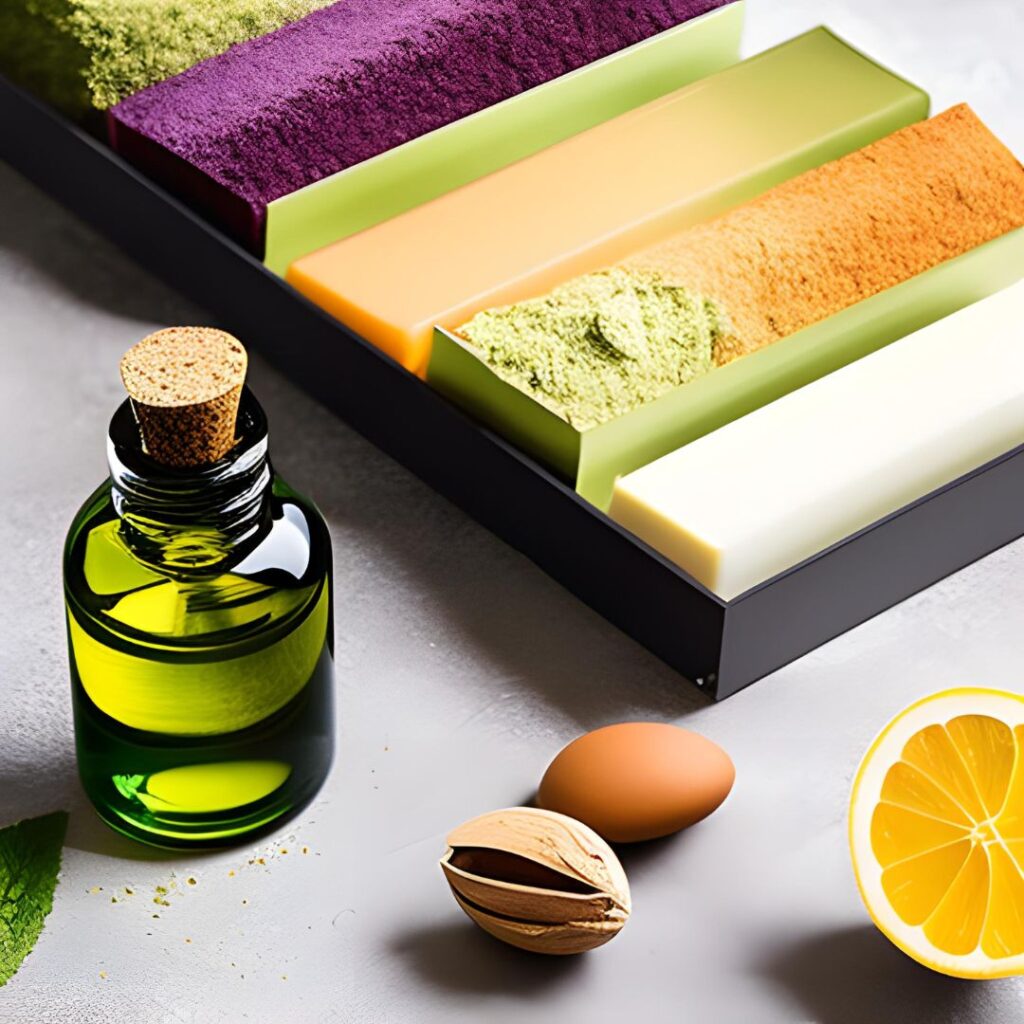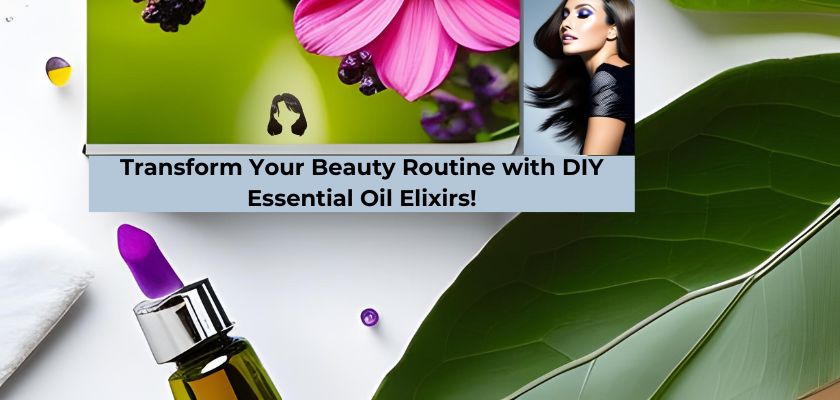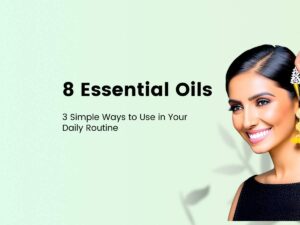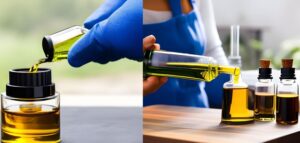It might be difficult to sort through the multitude of goods available on the market in today’s world, where the skincare and haircare sectors are flourishing. The abundance of substances that nature has given us can do wonders for our skin and hair, though. Plant-based essential oils provide a healthy and efficient way to improve our beauty regimens. To help you attain a glowing complexion and glossy locks, we’ll look at DIY essential oil recipes that are customized to various skin and hair types in this blog post. Prepare to discover the beauty of nature’s mysteries!


Essential Oils for Radiant Skin
Finding Your Skin Type: In order to tailor your skincare routine, it’s important to determine your specific skin type before diving into the recipes. Let’s look at easy techniques to identify your skin type.
How to Identify Your Skin Type: Determining Your Skin Type
It’s critical to determine your skin type before you can successfully tailor your skincare regimen. You can select the best products and treatments that address your skin’s particular demands by being aware of the distinctive features that make your skin unique. To discover your skin type, follow these easy tips:


1. Visual Inspection:
Dry Skin: Look for stiffness, flaky or rough spots, lack of a natural sheen or oiliness, and other signs of dry skin. Additionally, dry skin may seem dull and dehydrated.
Oily Skin: Excessive shine, larger pores, and greasy appearance, especially in the T-zone (forehead, nose, and chin), are signs of oily skin. Acne outbreaks are more likely on oily skin.
Combination Skin: The T-zone is oily, and the cheekbones and other parts of the face are dry. Oily, dry, or normal skin types can all coexist in combination skin.
Normal skin: Look for a uniform complexion free of obvious dry or greasy areas. Normal skin is flawless and has a healthy glow.
2. Touch and Texture Assessment:
Dry Skin: When touching dry skin, look for roughness, stiffness, and a lack of moisture. Additionally, fine lines and wrinkles may be evident on dry skin.
Oily Skin: Observe an oily or greasy texture, especially in the T-zone. Skin that is oily may feel greasy or have a thick, heavy texture.
Combination Skin: Skin with a combination of dry and oily patches should be noted for textural alterations. Patches of combination skin may be both smooth and rough.
Normal Skin: Look for a smooth, supple texture that is neither overly oily nor overly dry. To the touch, normal skin feels even and gentle.
3. Production of sebum:
Blotting Paper Test: Use blotting paper to test several parts of your face, including your cheeks, nose, and forehead. Keep an eye on how much oil the paper is absorbing. Higher sebum production and potentially oilier skin are indicated by more oil on the paper.
Facial Shine: Throughout the day, pay attention to how quickly your skin on your face becomes oily or greasy, especially in your T-zone. Shine that is too much is a sign of sebum overproduction.
4. Sensitivity:
Test for Sensitivity: Apply a tiny amount of a mild, hypoallergenic substance to a small patch of skin (for example, behind the ear), and look for any unfavorable reactions or symptoms of irritation. Redness, itching, or a burning sensation might occur on sensitive skin.
Product Reactivity: Think on how the skin responds to different skincare products. It may be a sign of sensitivity or allergies if you feel redness, itching, or breakouts after using a certain product.
You can learn more about your skin type by combining these tactile, visual, and observational indicators. Keep in mind that every person has a different type of skin, and that different parts of the face may have a blend of different skin types. Following the determination of your skin type, you may proceed to customize your skincare regimen and select the best essential oil formulations to bring out your natural beauty.
Recipes for radiant skin:


Recipe 1: Nourishing Facial Serum for Dry, Sensitive Skin: Dry and sensitive skin requires extra care and hydration. Here’s a nourishing recipe that will soothe and nourish your skin:
- 2 drops of Geranium essential oil
- 2 drops of Lavender essential oil
- 2 drops of Patchouli essential oil
- 1 tablespoon of Jojoba oil (or a carrier oil of your choice)
Recipe 2: Balancing Facial Serum for Oily and Acne-Prone Skin: Oily and acne-prone skin needs ingredients that balance and clarify. Try this personalized recipe for a balanced complexion:
- 3 drops of Tea Tree essential oil
- 2 drops of Lemon essential oil
- 1 drop of Clary Sage essential oil
- 1 tablespoon of Grapeseed oil (or a carrier oil of your choice)
Recipe 3: Revitalizing Facial Serum for Mature Skin: Mature skin requires rejuvenation and anti-aging support. Pamper your skin with this revitalizing recipe:
- 2 drops of Frankincense essential oil
- 2 drops of Rose essential oil
- 1 drop of Carrot Seed essential oil
- 1 tablespoon of Rosehip Seed oil (or a carrier oil of your choice)
How to Use:
Step 1: Mix the essential oils and carrier oil together in a small glass bottle.
Step 2: Shake the bottle gently to ensure the oils are well combined.
Step 3: After cleansing your face, apply a few drops of the serum onto your fingertips.
Step 4: Gently massage the serum onto your face and neck using upward circular motions.
Step 5: Allow the serum to fully absorb into your skin.
Step 6: Follow with your regular moisturizer or sunscreen, if desired.
Essential Oils for Lustrous Hair
How to Know Your Hair Type: Knowing your hair type is crucial for giving it the proper hydration and care. Let’s identify your hair type and look up recipes that will work for you.
Finding Your Hair Type: Knowing your hair type is essential for giving it the proper hydration and care. Knowing your hair type will help you customize your haircare routine to meet your hair’s unique needs. Let’s look at several methods for identifying your hair type:
1. Visual Examination:
Straight Hair: Straight hair is smooth and doesn’t have any obvious waves or curls. It frequently rests flush against the scalp.
Wavy Hair: Hair that is wavy has loose curls or a small “S” curve. It is in the middle of curly and straight hair.
Curly Hair: Hair that is curly produces definite spirals or curls. It could be tight coils or loose curls.
Coily Hair: Coily hair has tight, spring-like coils and is often referred to as kinky or tightly coiled hair. It frequently seems tightly packed.
2. Texture Assessment:
Fine Hair: Thin and delicate hair strands make up fine hair. They could be more brittle, but they often look smoother and feel lighter.
Medium Hair: The strands of medium hair are of a moderate thickness. They have an even texture that is neither too thin nor too thick.
Coarse Hair: The strands of coarse hair are substantial and thick. They may need more moisture and nutrients because they are frequently harsher to the touch.
3. Oiliness:
Dry Hair: Without natural oil, dry hair appears lifeless, brittle, and frizzy. It might need further moisturizing and hydration.
Normal Hair: Normal hair has a healthy gloss without being overly greasy or dry thanks to a balanced oil production.
Oily Hair: Hair that is oily tends to produce too much sebum, giving it a greasy appearance and necessitating more frequent washing.
4. Elasticity:
High Elasticity: Hair with high elasticity can be stretched without breaking and will quickly take on the shape it was originally given. It denotes hair that is wholesome and hydrated.
Low Elasticity: Hair with low elasticity is more brittle, does not stretch well, and is difficult to bounce back from damage. Additional conditioning and protein treatments might be necessary.
You can identify your hair type and choose the proper recipes and haircare products by keeping an eye out for these traits and taking into account how your hair behaves in terms of texture, oiliness, and elasticity.
Now that you know what sort of hair you have, let’s look at some DIY essential oil recipes that will nourish and condition your hair.
Recipes for Lustrous Hair
Recipe 1: Hydrating Hair Mask for Dry and Damaged Hair: Dry and damaged hair requires intensive hydration and repair. Try this nourishing hair mask:
- 2 tablespoons of Coconut oil
- 1 tablespoon of Shea Butter
- 1 tablespoon of Argan oil
- 3 drops of Lavender essential oil
- 3 drops of Ylang Ylang essential oil
How to Use:
Step 1: Mix the ingredients together until they form a smooth and creamy consistency.
Step 2: Apply the mask to damp, towel-dried hair from roots to ends.
Step 3: Massage the mask into your scalp and hair, ensuring even distribution.
Step 4: Leave the mask on for 20-30 minutes to allow the nourishing ingredients to penetrate.
Step 5: Rinse your hair thoroughly with lukewarm water.
Step 6: Follow with your regular shampoo and conditioner routine.
Recipe 2: Balancing Hair Serum for Oily Scalp and Hair: Oily scalp and hair need ingredients that regulate sebum production. Here’s a recipe to balance oiliness:
- 2 tablespoons of Jojoba oil
- 1 tablespoon of Grapeseed oil
- 1 tablespoon of Hemp Seed oil
- 3 drops of Cedarwood essential oil
- 3 drops of Rosemary essential oil
How to Use:
Step 1: Mix the carrier oils and essential oils in a small glass bottle.
Step 2: Gently shake the bottle to ensure the oils are well combined.
Step 3: Apply a few drops of the serum onto your fingertips.
Step 4: Massage the serum into your scalp, focusing on areas prone to oiliness.
Step 5: Work the serum through the lengths of your hair, avoiding the roots if desired.
Step 6: Style your hair as usual. The serum can be used on damp or dry hair.
Note: Adjust the amount of serum used based on the length and thickness of your hair. Start with a small amount and add more if needed.
Recipe 3: Strengthening Hair Spray for Healthy Hair Growth: Promote healthy hair growth with this revitalizing hair spray:
- 1/2 cup of Aloe Vera juice
- 2 tablespoons of Witch Hazel
- 10 drops of Peppermint essential oil
- 10 drops of Rosemary essential oil
How to Use:
Step 1: In a spray bottle, combine the Aloe Vera juice and Witch Hazel.
Step 2: Add the drops of Peppermint essential oil and Rosemary essential oil to the mixture in the spray bottle.
Step 3: Close the spray bottle tightly and shake well to thoroughly blend the ingredients.
Step 4: Before using, make sure your hair is dry or slightly damp.
Step 5: Hold the spray bottle about 6 inches away from your scalp and hair.
Step 6: Spray the mixture onto your scalp, focusing on the roots and areas where you want to promote hair growth.
Step 7: Gently massage your scalp with your fingertips to distribute the spray and stimulate blood circulation.
Step 8: Leave the spray in your hair and allow it to air dry. Avoid rinsing it out.
Step 9: Use the hair spray as needed, ideally once or twice a day, to nourish and strengthen your hair.
Note: Perform a patch test before using the hair spray for the first time to check for any allergic reactions. Discontinue use if any irritation occurs.
You may tailor your skincare and haircare routines with these DIY essential oil recipes to meet your unique needs. Always remember to conduct a patch test on your skin or hair before using any new product. Unlock the keys to bright skin and glossy hair by embracing the power of nature. Start today on the path to a more sustainable and natural beauty regimen!



